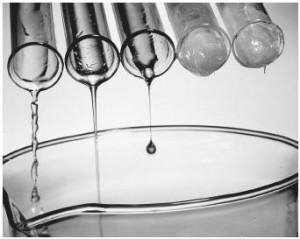 Viscosity is a measure of the resistance of fluid to an applied stress. In everyday terms it is like the “thickness” of a fluid or gas. For example, water has a low viscosity so it appears “thin”. In comparison, honey has a higher viscosity, so it appears “thick”. Viscosity essentially describes a liquids internal resistance to flow and may be thought of as a measure of its internal friction.
Viscosity is a measure of the resistance of fluid to an applied stress. In everyday terms it is like the “thickness” of a fluid or gas. For example, water has a low viscosity so it appears “thin”. In comparison, honey has a higher viscosity, so it appears “thick”. Viscosity essentially describes a liquids internal resistance to flow and may be thought of as a measure of its internal friction.Rheology is a more complex study of the flow of matter; mainly liquids, but also soft solids, gels, pastes and even sold materials that exhibit some level of flow (ie. do not just deform elastically). Rheology applies to substances that have a complex structure, including: muds, sludges, suspensions, polymers, petrochemicals and biological materials. The flow of these complex materials cannot be characterized by a single value of viscosity, instead viscosity changes with changing conditions. For example, ketchup’s viscosity lowers when it is shaken and cornflour’s viscosity increases when it is struck.
In practice, rheology is concerned with materials whose properties are between purely elastic material and Newtonian fluids, where mechanical behavior cannot be described by classic theories.
Do I need a viscometer or a rheometer?
There are several ways to measure the viscosity and rheological properties of a material. In both cases the most common testing methods are based around rotational devices that rotate a spindle immersed in a sample. By applying a controlled force or strain and measuring the resulting force or strain, it is possible to understand measure viscosity and understand rheological properties of a material.
The difference between a viscometer and a rheometer is essentially the quality of components and control capabilities. Basically, a rheometer is more versatile Download Mobdro and has a wider range of applications than a viscometer does.
A rotational viscometer is a simple device that rotates a spindle in a single direction. Most viscometers have mechanical bearings that limit the range of applications to more viscous materials. A viscometer is a low cost instrument that is suitable for simple material, process or production tests that require simple flow measurements. A viscometer is highly suitable for quality control testing and is often portable so offer the ability to do remote or field testing.
A rotational rheometer allows far greater characterization of flow and deformation behavior. Rheometers can apply oscillatory motion to the spindles and can also apply large step changes in stress and strain to determine viscoelastic properties as well as flow properties. Rheometers usually use ultra-low friction air bearings which enable much greater sensitivity for low viscosity samples to be measured. Rheometers also tend to offer a wider range of sampling accessories such as temperature control units to study materials under a wider range of conditions.
A rheometer usually represents a greater investment, but can be essential for the true simulation of real processes and complete material characterization. The increased versatility of a rheometer makes it an excellent tool for research, product and process development as well as quality control testing.
Both instruments are complimentary and it is not uncommon to see viscometers and rheometers in a single organization.
Source: www.zimbio.com/Rheology
Leave a Reply
You must be logged in to post a comment.